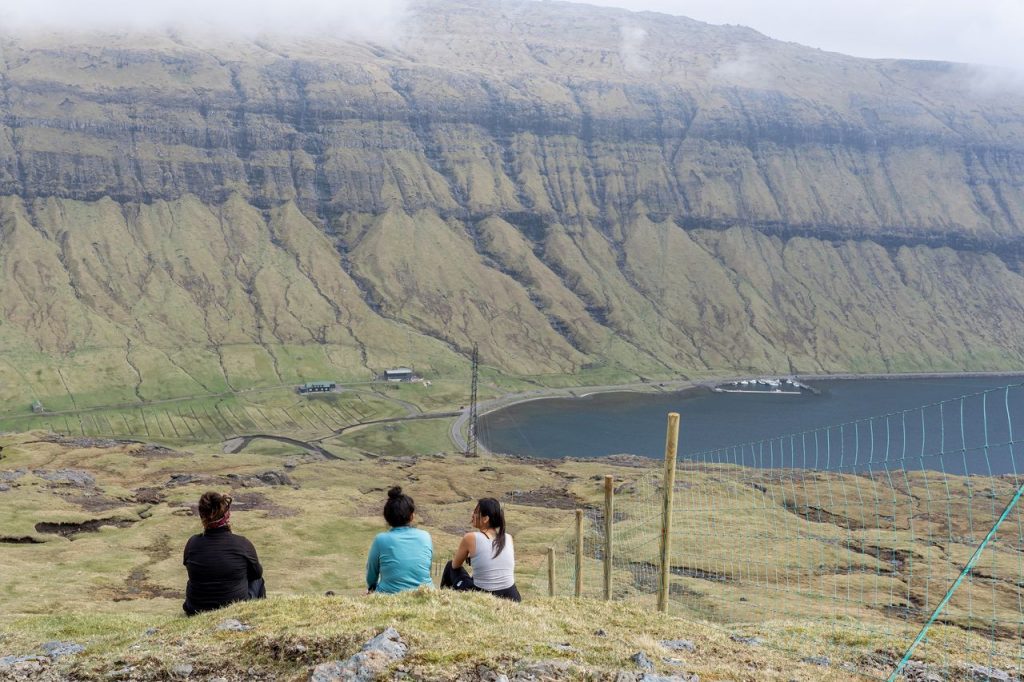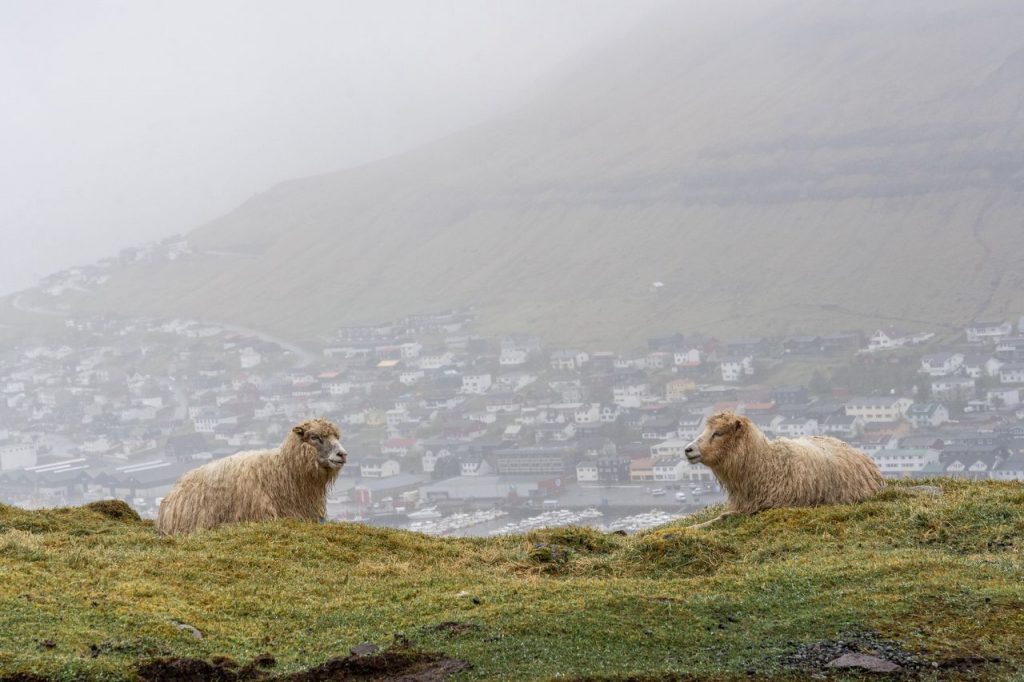THE LAST WOODEN POLE had just been driven into the damp ground and the final roll of fencing nailed in, when I noticed movement in the fog ahead of me: Two sheep stared at me—from the wrong side of a fence we’d spent the last three days building to keep them out.
“I’ll get them later,” the foreman said. “Your job is done.”
This was my second visit to the Faroe Islands, 18 windswept, treeless islands in the North Atlantic halfway between Iceland and Scotland. On my first trip, I had sped through a greatest-hits list of Faroese sights, from the puffin colonies on the island of Mykines to the turf-roofed church at Saksun.
My return visit had been different. For one thing, I’d spent most of my time in a single valley. And as the creakiness in my knees attested, I had been put to work.
In 2019, Visit Faroe Islands, the tourism board of the Faroe Islands, a self-governing territory of Denmark, unveiled the “Closed for Maintenance” program . For three days, officials would close a selection of major attractions to visitors, while a group of around 100 lucky volunteers from around the world would fly in and work to maintain those attractions, building trails, erecting signs and installing other infrastructure. This year, the competitive program attracted some 6,000 applicants—all eager to get their hands dirty in this land of around 50,000 people.

Volunteers take a break from putting up fencing as part of the Sundshagi project.

Sheep rest above Klaksvík, the second largest city in the Faroe islands.
This spring, with the program in its fifth year (it was paused in 2020 due to Covid), I was fortunate enough to be chosen. Beyond putting my knees through their paces, I hoped to better understand why thousands of people want to come to this remote corner of the North Atlantic known for bad weather to move stones and hammer in nails.
I wondered if it was just a marketing stunt. After all, I was selected in part because I’m a journalist. A handful of other international journalists were also accepted, part of what Visit Faroe Islands’ development director Jóhan Pauli Helgason calls its “organic marketing” strategy. For a place that few people can point out on a map—and that is sometimes known, if at all, for its controversial whale-hunting traditions—tourism stakeholders are eager to get the word out. That said, they acknowledge the slippery slope toward overtourism, which locals fear.
Both concerns seem to drive the program more than any real need for volunteer labor. “We’ve seen the example in neighboring countries of what can happen when tourism grows too fast,” Helgason said, invoking Iceland’s struggles with huge crowds. “We think Closed for Maintenance might help us attract the right types of travelers, those that are conscious and want to really engage with a place.”
So strong is the demand for the program that I heard more than one volunteer refer to it as winning the lottery. Visit Faroe Islands says about a third of volunteers are accepted based on specific skills they bring—trail maintenance, for example, or, in my case, the ability to report on the experience—but most are randomly chosen. (Although I stayed with a local family like the other volunteers, The Wall Street Journal covered my other expenses.)
Over the course of three days in May, 80 volunteers were spread across eight projects, ranging from trail building to, in my team’s case, habitat restoration. Kolbrún í Haraldsstovu, a plant ecologist who heads up the botany department at the Faroe Islands National Museum, has been on a yearslong mission to rekindle biodiversity in the islands by fencing off swaths of land from the islands’ 70,000 ubiquitous—and, at times, destructive—sheep.
“We have all this grassland that people think is wild, but it’s actually pretty barren because it has been dominated by sheep since the settlement of the Faroes [around 1,500 years ago],” í Haraldsstovu explained. “I want to see what nature looked like here before the sheep came.” Our site, Sundshagi, was chosen largely because the two farmers who owned the land were willing to donate a few acres for the project, which would entail erecting more than 3 miles of fencing.
For í Haraldsstovu, collaborating with Closed for Maintenance was, in part, to raise awareness about the Faroe Islands’ biodiversity problem. “I could hire a bunch of farmers to put the fencing up, but then it would only be the farmers who would understand what we’re doing here, instead of all the local and international volunteers doing the work,” she said.

GOLDEN TICKET Volunteers accepted into the Faroe Islands’ popular Closed for Maintenance program work on putting up a fence to keep sheep out of a protected area.
On the first day of work, heavy fog blanketed everything in a steely gray haze. The 17 other volunteers on my team, from 10 different countries, including some locals, vanished and reappeared as they lugged materials through the valley; disembodied voices and the sound of hammering floated through the fog. But on the second day, the sun made everything gleam. The relentless trilling of oystercatchers, the Faroes’ national bird, provided a soundtrack.
The repetitive—and at times grueling—work offered ample time to connect with fellow volunteers, as well as the three paid professionals correcting our blunders. Many members of my team said they’d applied to the program multiple times. Monica Quevedo, 33, a Bolivian Ph.D. research fellow in Denmark, had unsuccessfully tried her luck twice before. She told me her academic interest in agriculture and environmental conservation overlapped nicely with the Sundshagi project.
But many volunteers I spoke to—a Bulgarian policy adviser in Brussels, an Iranian student in Rome, a digital marketer in Seattle—said they weren’t drawn primarily by the program’s educational opportunities, nor by pat-on-the-back feelings of self-fulfillment. Most volunteers, myself included, were driven by a (not entirely selfless) desire for access to the community deeper than the usual surface-level tourist interactions.
“I mean, look where we are right now and what we’re doing,” said Sharne Bloem, a 46-year-old architect from South Africa, as she pointed at a pack of sheepdogs running through the fog in Kaldbak, the village where we stayed. “Most tourists don’t see this side of a place.”
Postwork evenings started with dinner served in the house my team shared—five air mattresses, side by side, were crammed into one room—and often ended with a bottle of aquavit, the local spirit, being passed around.
“I live 15 minutes from here and could be home right now in a much more comfortable bed,” said Rúni Juul, 47, a local schoolteacher who has volunteered for the past three years. “But I’d be missing out on these interactions.”
After the program ended, my newfound interest in the evolving relationship between farmers, conservationists and tourists led me to Hanusarstova , a farm in the seaside community of Æðuvík. There, fifth-generation farmer Harriet Olafsdóttir av Gørðum and her husband John av Gørðum raise sheep, but also use their land—and social-media platform—to start more complicated conversations.
On tours of the farm, the av Gørðums explain the way sheep have altered the landscape of the Faroes. They also introduce guests to four of the last 82 Faroese horses left on earth, whose repopulation efforts they hope can be folded into the Closed for Maintenance project in future years.
“I want this farm to be a kind of sanctuary, a place to learn and also an area that brings back some of the nature we’ve forgotten about,” Harriet said. “I want to help find the future in the past.”
On one of my final days in the Faroes , I reunited with Petur Nicolajsen, 27. The engineering student had been one of the professionals on the job and had taught me how to drive in nails and tighten fencing as we traded stories from our lives.
He had expressed some misgivings about my future as a fence builder: “The poles aren’t the straightest all the way around, but we knew what we were getting,” he joked. Yet he found my company tolerable enough to invite me to his home on the island of Sandoy, recently connected to the capital by a nearly 7-mile subsea tunnel.
“I don’t think tourism is too big yet; tourism is just too unmanaged,” Nicolajsen said, as we hiked toward the jagged cliffs on the island’s northwestern coast.
Northern fulmars, gull-like seabirds, glided over the cliffs in wide, loping patterns. In a few weeks, Nicolajsen explained, he’d be back here along with a few dozen others. They’d don harnesses and rappel more than 1,000 feet down to collect hundreds of fulmar eggs, a local delicacy.
I sat in the damp grass—it has always just rained in the Faroe Islands—and watched the fulmars spin in the late-afternoon sunlight. Our fence, I knew, would probably have been built with or without us. The volunteers could have applied their efforts to any number of projects back home, with cushier accommodations and better weather. Yet the lottery’s going on its fifth year now, and each time people try their luck. The lottery had brought me here. As the sun broke through the clouds and Nicolajsen crawled to the edge of the cliff, pointing out where he and other egg-gatherers would soon go in search of their own treasure, I knew I’d hit a jackpot.
THE LOWDOWN / The Faroes for Non-Volunteers
Getting there
National carrier Atlantic Airways , along with Icelandair and SAS , fly to the Faroes’ Vágar Airport from Reykjavik, Oslo, Copenhagen, Paris and a few other European cities. (Atlantic Airways also operates a weekly flight between the Faroes and Stewart International Airport, about 60 miles north of Manhattan, in September and October). A word of warning: Wind, fog and rain can often lead to flight cancellations and delays so it pays to bake in a few contingency days.
Staying there
Most travelers choose the capital, Tórshavn, as a homebase. Hotel Føroyar , a turf-roofed hideout, and Havgrím Seaside Hotel 1948 , both just outside the city center, are among the more luxurious options. Home rentals in the city, including in the quaint Old Town of Reyn, will have you closer to the action, though you’d be wise to follow the posted advisories to tourists asking they respect residents’ privacy. Well-maintained roads and a remarkable network of terrestrial and subsea tunnels makes exploring by rental car very easy.
Eating there
For a country of just 50,000 people, the Faroe Islands punches well above its weight class when it comes to gastronomy. Before your trip, secure a reservation at Ræst , where Puebla-born chef Sebastián Jiménez combines his Mexican heritage with Faroese fermentation traditions, making what can otherwise be an acquired taste much easier to fall in love with. Fermented sheep intestines, langoustine brains and fulmar breast all make an appearance on the prix fixe menu—and you’ll be happy they do. At the adjacent ROKS , seafood plays a starring role and guests have a choice between two menus. Close to the airport, the more casual cafe Fiskastykkið serves a fish soup that can restore even the most wind-battered, rain-drenched soul.
Getting in on the lottery
Visit Faroe Islands opens up applications for the Closed for Maintenance volunteer program in the fall. Applicants are asked to write why they want to take part and are told, in January, if they were selected. Once informed, volunteers have 48 hours to book their flights before the slot is opened to other applicants. Accommodations vary widely depending on which project volunteers are assigned to—from remote cabins with no electricity to individual rooms in guest houses.


